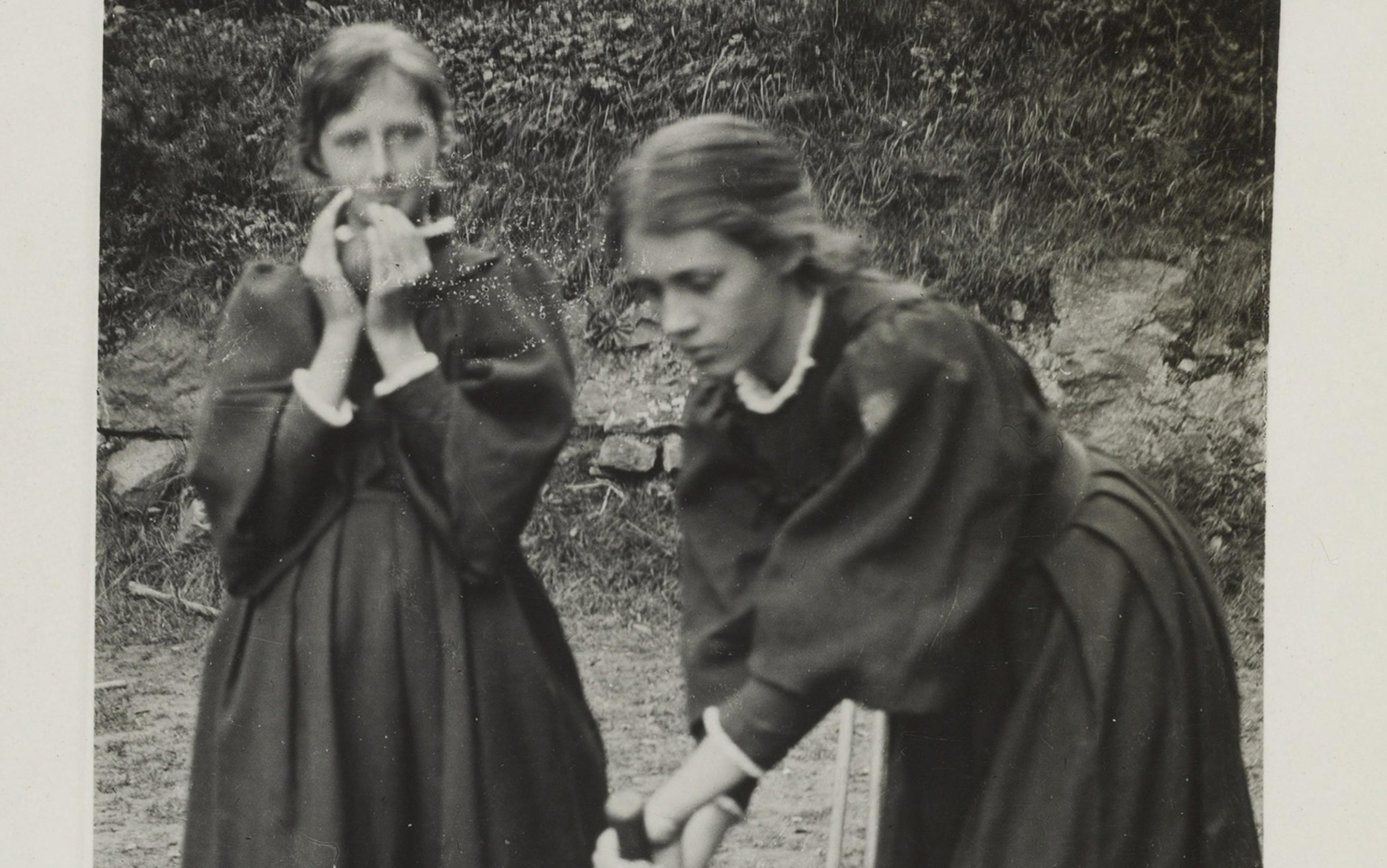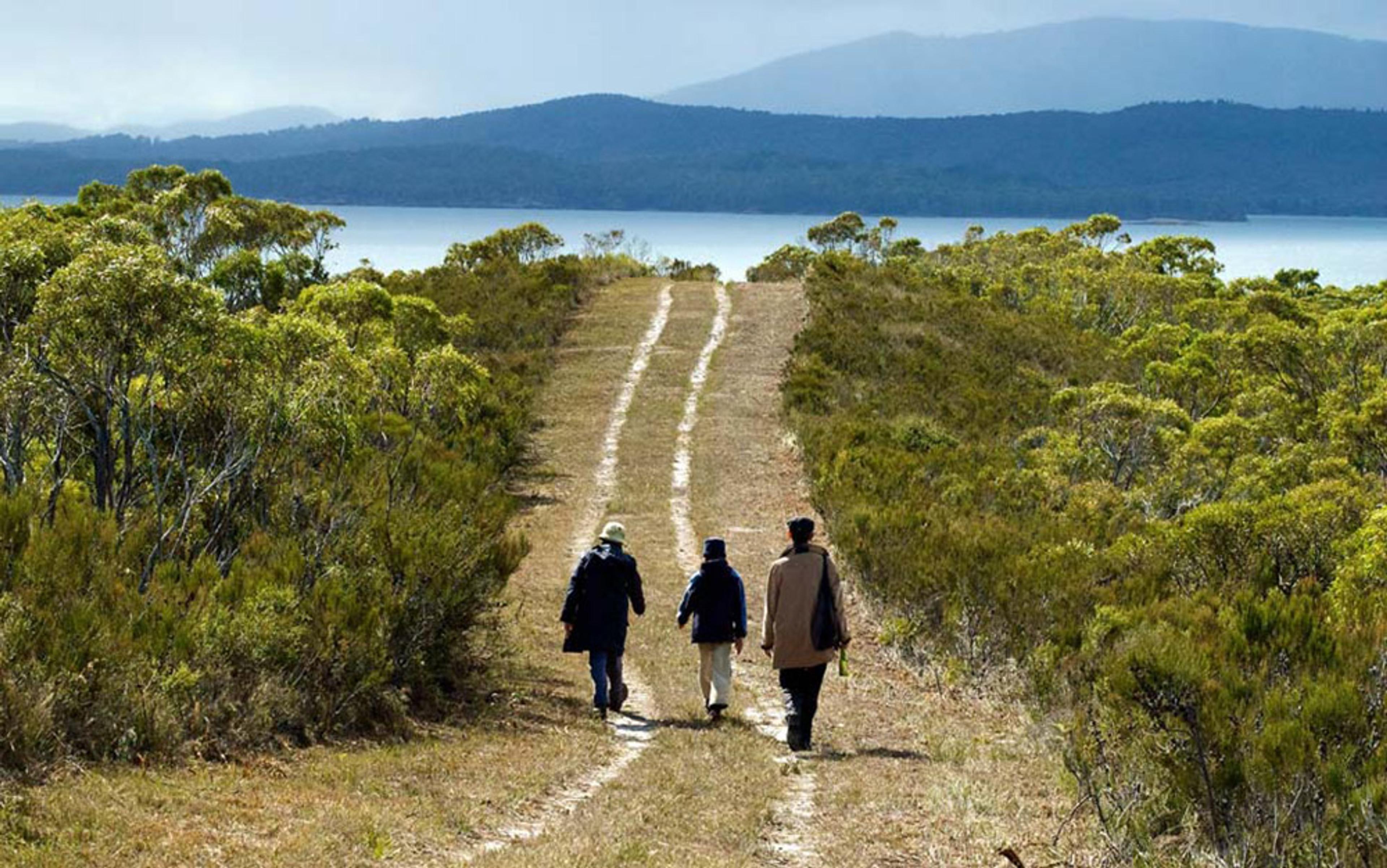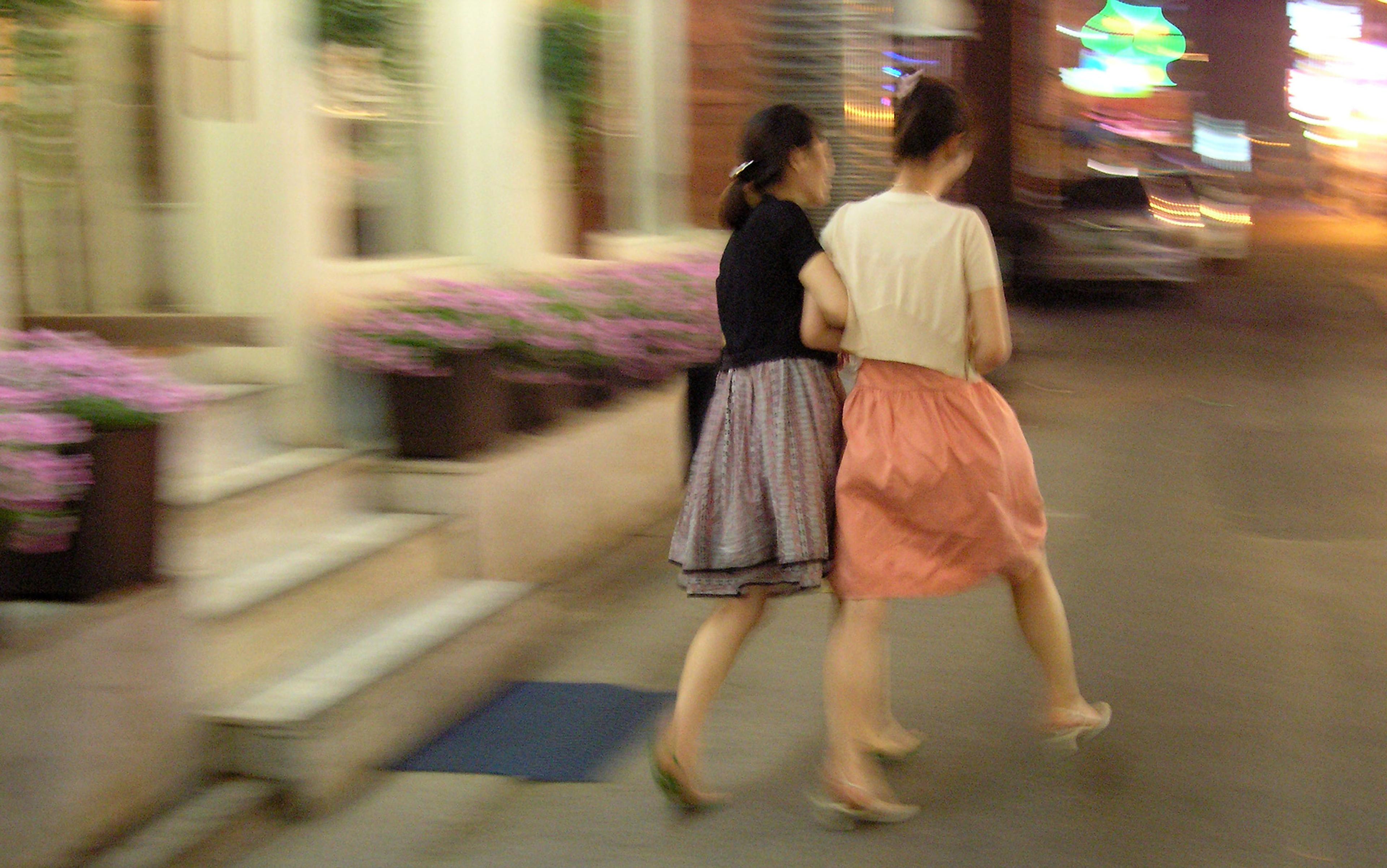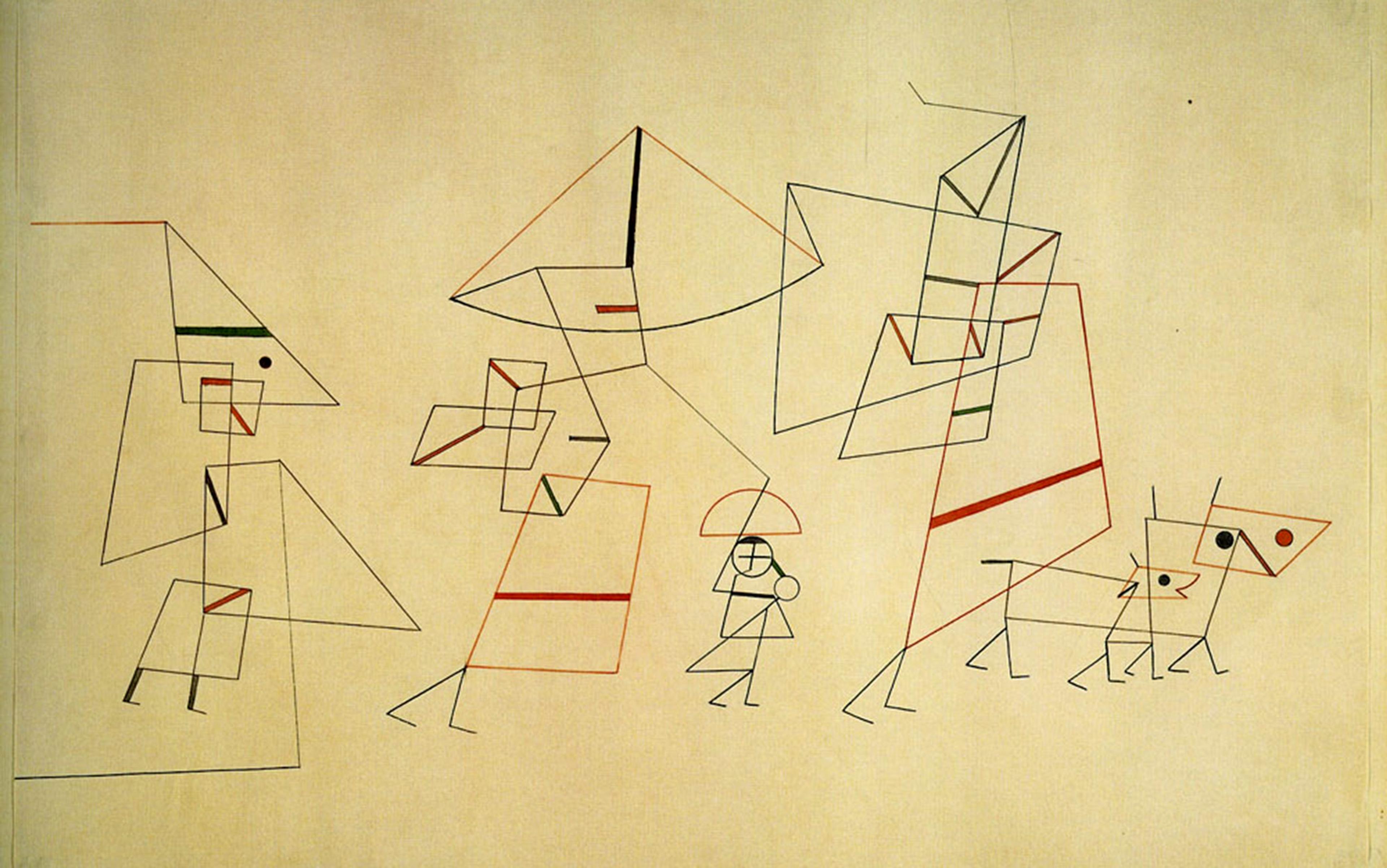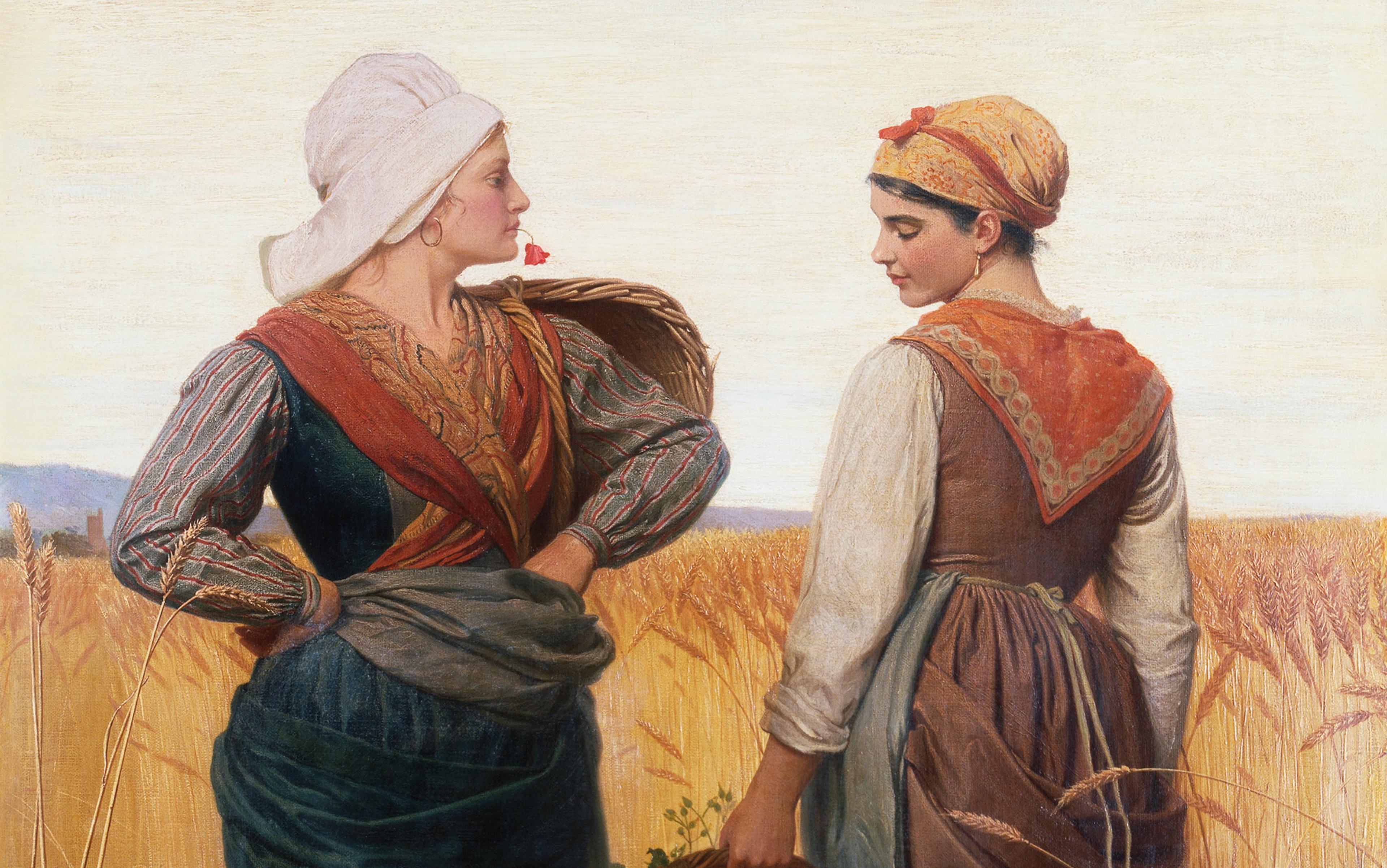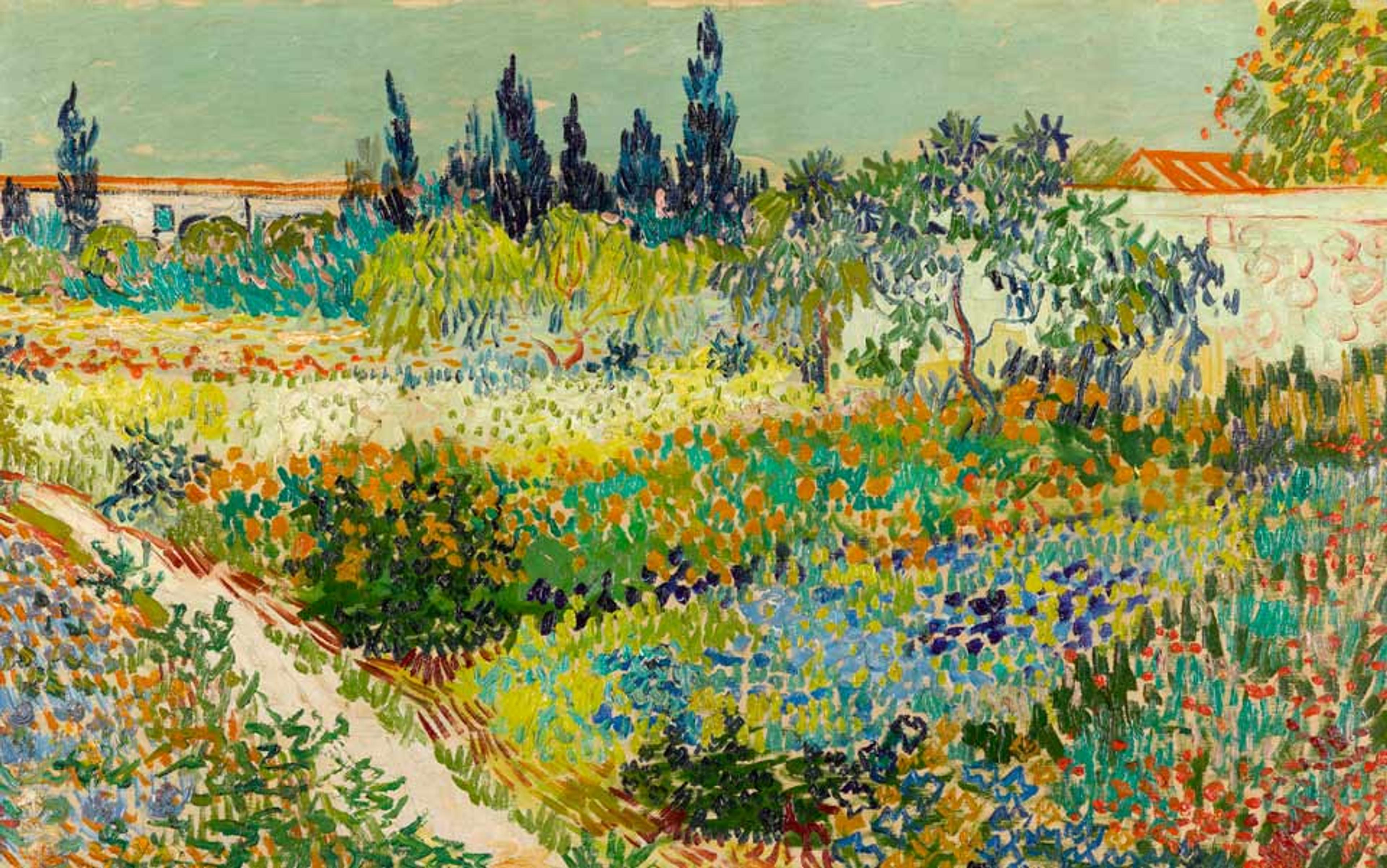Before me are two portraits of famous sisters as children. They have that fixed quality of 19th-century photography. In one, a girl, sullen and serious, challenges the camera with passive resistance, hair as dark as her eyes; in the other, the girl glances upwards towards the light, her face set in a halo of ivy. The first girl clearly doesn’t want to be photographed; the second is serene, trusting, open. The portraits are of Vanessa and Virginia Stephen, and the photographs are in my mother Jane Dunn’s double biography, Virginia Woolf and Vanessa Bell: A Very Close Conspiracy (1990). Earth and air; sensuality and intellect. Despite their dazzling differences, they appear like mirror images on opposite sides of facing pages. When I close the book, they fold together cheek to cheek.
Side-by-side, mirroring, similarity. These are words we associate with the sisterly bond. Faced with your sister, you are as close to yourself as you will ever be: both female, often only a few years apart, with the same family inheritance, the longest relationship of your life. Sisters have the capacity to touch a sensory nerve in each other, as much for pleasure as for pain: ‘it is sisters who weave the most complex webs of love and loyalty, resentment and hurt,’ my mother wrote in the preface to Daphne du Maurier and her Sisters (2013). As the eldest of six sisters herself, she loved writing about the sisterly relationships of others.
Like magnets, sisters draw close and repel. What is this double-sided feeling? This need to be different in the face of blatant similarity. And what of women’s rivalry? How closely aligned is love with envy and jealousy? It is illuminating to look at the most creative of sisterly relationships between the painter Vanessa Bell and her younger sister, the author Virginia Woolf, to understand how their closeness was forged, as well as their strategies for maintaining separateness and individuality.
Vanessa, older by three years, had experienced life without her sister, whereas Virginia knew herself only with Vanessa at her side. Vanessa also learned that with Virginia came the adult corruption of comparison. In early diaries, she reflected on how much easier life might have been if she’d remained an only child:
No one ever says how nice Mary is or how lovely Jane; but always Mary is nicer than Jane and Jane prettier than Mary. It’s inevitable, and comparisons are the easiest form of criticism, no doubt, but it may lead to trouble.
Vanessa was right. This is the seed sown into too many childhoods.
Virginia was beautiful and intelligent, and the adults were charmed by her. Vanessa, too, was charmed by her sister. She completely understood how irresistible she was. But while her younger sister shone, Vanessa didn’t thrive in the limelight of adult attention. She quickly learned to withdraw from the verbal and intellectual worlds where Virginia reigned. She didn’t enter the unequal competition; instead, she developed the practical and maternal elements in her own character, and learned to guard her art secretly. Virginia loved these qualities in her older sister; her admiration for Vanessa was passionate, binding, and at times obsessive. From early on, the sisterly bond was both inhibiting and inspiring. They closed ranks against the world.
Virginia was open about her passion for her older sister, made more intense after their mother died when they were young, followed by the death of their half-sister who had adopted the maternal role. In her possessiveness, Virginia liked to remind her older sister that she was Vanessa’s ‘first born’.
Together, the two sisters had to defend themselves from a Victorian father who believed a woman’s role was as comforter and complement to father and then husband; intellect in a woman was a hard edge that should be kept hidden. Denied school, they were expected to learn music, dancing and how to preside over a tea table. Virginia’s grasp of literature was wholly self-taught – she spent her days freely in her father’s library, but she had to wait for her brother Julian’s (fondly known as Thoby) return from school, then university, to glean what she could from his education in the Classics, her particular passion. This glimpse of what formal education offered the sons of the middle and upper classes was the beginning of a lifelong anger at what had been denied to her, her own sex. ‘Women have served all these centuries as looking-glasses possessing the magic and delicious power of reflecting the figure of man at twice its natural size,’ Virginia wrote years later in her witty polemic, A Room of One’s Own (1929).
Each had money to exist without marrying, and each achieved her very own ‘room of one’s own’
The two sisters guarded their interests and independence fiercely, and together they formed their own nucleus. ‘We had an alliance that was so knit together that everything … was seen from the same angle; and took its shape from our own vantage point,’ wrote Virginia. When they stepped into the world, they were masked in the uniform of upper-class Victorian beauties and were often seen as an entity. To the mostly male audience of their brothers’ Cambridge friends, they were considered the Stephen Sisters, ‘beautiful, silent, remote’. Their protective bond of sisterly separateness offered only a precarious power, sidelined as they were by social custom to being ‘Other’ – a dubious state that Simone de Beauvoir would later explore in The Second Sex (1949).
But there was a short period of total freedom after their father died, when the sisters and their two brothers, all unmarried, moved together to 43 Gordon Square, an airy Georgian townhouse in Bloomsbury near the British Museum in London. Vanessa and Virginia could be themselves at last, away from Victorian propriety and the disapproving aunts. Each had money enough to exist without marrying, and each actually achieved her very own ‘room of one’s own’: Vanessa’s in which to paint, Virginia’s to write. Almost immediately, their house became the centre for those Cambridge friends who gathered to discuss literature and art. The two women – creative, productive, free – became the beating heart of the Bloomsbury Group.
The significant men in the sisters’ lives found them oddly interchangeable. When Clive Bell first met Virginia and Vanessa, he had been drawn to them both. He had actually found Virginia more attractive, though he married Vanessa. Leonard, who was to become Virginia’s husband, writing in his diary of when he first saw the two sisters, referred to them as if they were one: ‘It was almost impossible for a man not to fall in love with them, and I think that I did at once.’ He was first attracted to Vanessa, but when she accepted Clive’s proposal, Leonard switched his attentions to Virginia. Even the unambiguously homosexual Lytton Strachey idly (and fleetingly) imagined himself married to both.
Yet the sisters saw themselves in each other, too. Each lived vicariously through the other. In this light, Virginia’s description of Elizabeth Barrett Browning’s relationship with her dog Flush reads as a metaphor for the sisters’ bond:
There was a likeness between them. As they gazed at each other each felt: here am I – and then each felt: But how different! … Broken asunder, yet made in the same mould, could it be that each completed what was dormant in the other?
But mirror images can distort as well as illuminate. Virginia was struck with jealousy when Vanessa broke the sacred bond of sisterhood by marrying. Suddenly, Vanessa blossomed as a sexual being and seemed to inhabit an unreachable world. At first, Vanessa had resisted all of Clive’s proposals, but the sudden death of their beloved brother Thoby from typhoid in 1906 propelled her into Clive’s arms. For Virginia, the loss was threefold, a brother, then her sister, and Clive too, one of the close circle of friends. ‘Nessa has all that I should like to have, and you have her,’ she wrote poignantly to her brother-in-law.
I know this sisterly dependence, and how we mirror those women who are close to us, how identifying with them leads to comparison. Having been brought up by my mother, with her phalanx of sisters, I was primed for sisterhood, but having no sister of my own I set out in search of one, and there I found Astra in our third year of university. A relationship that surprised me in how quickly it turned from admiration to rivalry, diverted by the snake bite of envy.
On the face of it, Astra and I were very different: she was from York, the first woman in her family to go to university. She was very pretty, but she had an edge – her fake front tooth, now stained grey, was earned in childhood when she’d knocked the original out in a public swimming pool. Her shiny dark hair was cropped short to my messy blonde, her sass a contrast to my peach. She was outspoken; I was quiet. Yet we had a shared sensibility, spoke the same language. In the absence of a sister, our bond felt as strong.
Our sense of oneness thrilled me. Like Virginia and Vanessa, we complemented each other, and I was filled with admiration for her. Astra was the young woman I wanted to be.
Her radiance seemed only to diminish mine, as if there was not enough room for us both in the firmament
The psychoanalyst and philosopher Jacques Lacan recognised the mirror stage as fundamental to human development. It’s that moment when the baby, at around six months, recognises herself in her reflection and realises that she is an individual; not simply a floating mass of instinct and desire, her consciousness still awash with the stream of her mother’s. She sees herself as an object among other objects: the toys on the floor, the bottle, the bed – as ‘other’, as over there. But, according to Lacan, throughout a person’s life, this objectification can be self-alienating, creating mixed feelings of the self that oscillate between love and envy – between a desire to be that image and a fear that it’s out of reach. This is complicated further by the reflection gazing back. Faced with herself in a mirror, a woman sees not only with her eyes, but with the eyes of the world as well. If we are to stand by Beauvoir’s thesis, culturally women’s experience of themselves is distorted through the prism of the male gaze, or what women believe to be male desire. As she reminds us: ‘One is not born, but rather becomes, a woman.’
To start with, Astra was my polestar, but with admiration came envy for the qualities I wished I embodied myself. I could live with this mean feeling if she remained my friend and be reminded through her of what I aspired to be. But jealousy is the fear of losing something you have. It’s a disappointing cliché that it was men that made me realise this. When we met two guys, old mates who shared a Brixton flat, and started dating them in our own boozy version of Friends, the worm of rivalry grew. My focus on her beauty became more acute; the way she wore clean white linen, which showed off her tan; the sparkle in her cheeks; how she glittered; how she lived up to her name. Everyone who met her commented on her beauty. I wanted to be happy for her, I told myself, repeatedly. She is your friend. You love her. But her radiance seemed only to diminish mine, as if there was not enough room for us both in the firmament.
If I love you, I thought, then surely everyone else will love you too, which led to a painful conviction that my boyfriend saw what I saw, that he too was in love with her. If my envy corrupted my love and admiration, then my fear of losing my partner sparked my jealousy. I am still ashamed to admit all this, because Astra did nothing to provoke it. I felt unable to compete, but unlike Vanessa Bell I didn’t find my own areas of excellence. Instead, I became a shadow of my former self, incapable of standing shoulder to shoulder beside the person I most wanted to be aligned with, us against the world.
It was also a man who came between Vanessa and Virginia. Despite the thrill of discovering herself in sex and marriage and motherhood, Vanessa had moments of deep despair. She no longer had freedom, time to paint, and she missed her sister. She was already lonely in her new role when Virginia and Clive struck up an intellectual flirtation. The two most important people in her life were in an alliance that excluded her. This betrayal was all the more painful for Vanessa because she admired Virginia as much as Clive did. Her letters at this time were full of her need for Virginia’s affection and reassurance. In middle age, she recalled a discussion with the artist Duncan Grant, when she’d suggested that the intensity of emotion is in direct relation to one’s evaluation of the person who aroused the jealousy. She produced Virginia as an example of someone whom she’d been most jealous of, at a time when she admired her more than any woman she knew.
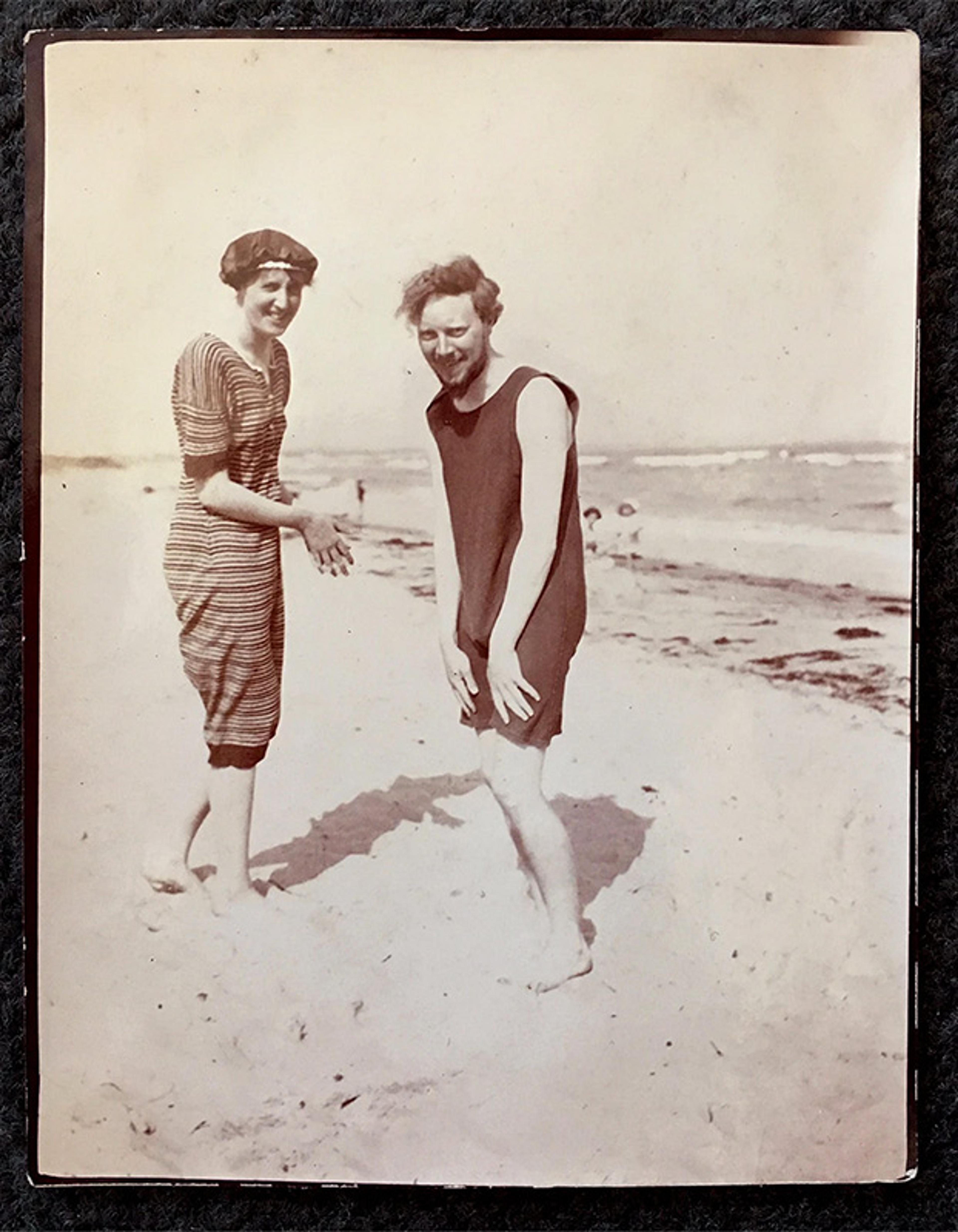
Virginia Woolf and her brother-in-law, Clive Bell, in 1910. Courtesy the New York Public Library
And what of Clive? Like so many men, he felt eclipsed by the demands of his new baby with Vanessa. But what if his flirtation with Virginia was also his way of breaking the sisterly bond? ‘How better to weaken their solidarity than to woo both and set up a sexual rivalry, albeit covert, one sister against the other?’ wrote my mother. With Vanessa’s discovery of the power of maternal love, both Clive and Virginia suffered a sense of exile from her. It pained Virginia that she was no longer Vanessa’s ‘first born’ but, instead of acknowledging their changed circumstances, Virginia betrayed the one she loved most. The flirtation was always about Vanessa, never about Clive. Through their connection, Virginia hoped she could reach through the void and touch Vanessa again.
Looking back on my own friendship with Astra, I remember wondering why we couldn’t both shine: why one woman’s power must diminish the other’s? Why, when men came into the frame, did our closeness turn to competition? It feels such a cliché now – the triangular relationship – and a man at its centre. But traditionally, it is the man who gifts the woman her self-esteem. Was I living out this legacy? Was my jealousy so bound up in my boyfriend’s approval – a fear from the depths of the collective unconscious that the loss of his love was also a loss of a reason to live?
Perhaps we need to go back to antiquity for perspective. The Judaic story of Leah and her sister is an early allegory of this dynamic triad. Not only are Leah and Rachel sisters, they are both married to the same man, Jacob, and they believe that their spiritual value and progression towards God is reliant on how many sons they can produce for him. Written by men for men, it is important to the Biblical story that the sisters are different: ‘Leah was tender eyed; but Rachel was beautiful and well favoured.’ Jacob always loved Rachel more than Leah; originally, it was her he wanted to marry, but he was tricked by the sisters’ father into marrying Leah first, as she was the elder. Leah was never happy in marriage, as she knew that she would never usurp Rachel as Jacob’s favourite. God took pity on her for being unloved, and blessed her with fertility. She produced seven children for Jacob, six sons and one daughter, while Rachel discovered that she was barren. It was only many years later that God took pity on Rachel (whose womb he’d cursed to punish Jacob) and ‘permitted’ her to have two sons of her own. With the tables now turned, the envy was all Rachel’s. Despite being the beautiful, chosen wife, Rachel was not allowed by God to have everything.
Two halves of a whole, the Madonna and the whore, their identities seen purely in relation to the masculine
In Dante’s third and final dream in Purgatorio, which like the others happens just before dawn (the time that we are most alert to essential reality in symbolic form), Dante dreamt of these biblical sisters. In his dream, Leah is the more active of the two, always ‘doing’, gathering flowers, taking part in the practical arts, weaving a garland; meanwhile, Rachel represents the more contemplative ‘seeing’. In ‘The Dream of Leah and Rachel’ (2019), the Dante scholar Andrew Frisardi argues that, together, these sisters are the perfect vision of the active and contemplative life necessary for regaining Paradise:
In Dante’s dream, Rachel and Leah combined can be seen as figures for artistic mastery … The two feminine figures constitute a continual cycle between contemplation and doing, knowing and making.
The story shows us that these qualities are not sufficient in themselves but combined they can achieve anything. In comparing themselves with each other, Rachel and Leah only highlighted what the other lacked, triggering a desire for what the other had: the very thing that would make them complete – Rachel’s contemplative nature with Leah’s active creativity.
I am reminded here of Sylvia Plath and Assia Wevill, not sisters, not even friends, but in a relationship that was claustrophobic and destructive from the start, when Assia’s envious eye focused so sharply on Sylvia as a rival whose poetic talent and fame she craved. Assia’s acquisitive impulse started carelessly, with a boast to her colleagues that she was going to ‘seduce’ Sylvia’s husband, the poet Ted Hughes. At the time, Assia and her husband were renting the Hughes’ London flat in Primrose Hill – Ted later wrote that ‘she sniffed us out’ – and it was not long before Assia made good on her intent. When Sylvia discovered Ted’s affair with Assia in July 1962, she stormed out, taking their two small children with her, and renting a flat across town where she wrote in a kind of demented fury at least 26 of the poems that would form her posthumous collection Ariel (1965). In the unremitting fog of depression, she went on to write her only novel, but neither art nor medicine could claw her back from the brink. A month after The Bell Jar was published in January 1963, Sylvia took her own life.
After Sylvia’s death, Assia continued a fractured relationship with the grieving poet, living with him in Sylvia’s flat – which she called ‘the ghost house’, sleeping in her bed and caring for their children. She couldn’t escape what she had unloosed, the shade of a woman whose life and spirit grew to saintly proportions after her death. With a kind of terrible symmetry she, too, died by suicide, and by the same method as Sylvia, poisoning herself with the domestic gas supply. But unlike Sylvia, Assia took Shura – the four-year-old daughter she’d had with Ted – with her. Perhaps, as with Virginia’s encroachment on her sister’s marriage, Assia’s envy was more about Sylvia than Ted. Assia was a writer, after all, but a copywriter with literary ambitions. She couldn’t compete with Sylvia in that rarefied world, but she could try and assume what she had.
Watching this drama unfold, the press portrayed it as the perfect tragedy, the triangular love affair – two women fatally in love with one man, the age-old trope of female jealousy and the primacy of the male. The stereotypes it trotted out diminished both women – the mother and neurotic housewife superstar (Plath’s poetic genius was an inconvenience to this fantasy) brought down by the seductive and reviled other woman. Two halves of a whole, the Madonna and the whore, their identities seen purely in relation to the masculine.
Envy and jealousy are complex emotions, and they are part of the human heart. We are all plagued at times with a sense of inferiority, wrote the psychoanalyst Alfred Adler: ‘The greater the feeling of inferiority that has been experienced, the more powerful is the urge for conquest and the more violent the emotional agitation.’ We all are driven by a need to feel superior, regardless of our success or status. It is one thing to feel these emotions, and another to act them out. Most of the time, the sisterly bond contains the mirrored desires of each sister easily and comfortably within itself: the interdependency and self-sufficiency of the Stephen Sisters was so powerful that it unsettled those who were close to them. Likewise, when things were good between Astra and me, we desired nothing more. It is only when the balance is thrown that envy and rivalry erupt. At least, Vanessa Bell and Virginia Woolf were instinctual enough to divide up the world between them, art and literature, the sensual and the intellectual: ‘You have the children, the fame by rights belongs to me,’ Virginia said to Vanessa, only half in jest.
The refrain ‘She’s just jealous’, so often used to describe spiteful or cruel behaviour between girls or women, often friends, is well-worn. It is a feminist tragedy that women’s relationships are expected to be veined through with envy and competition, thereby undermining the strong and supportive solidarity that most women value.
Astra and I were lucky. After the initial phase of insecurity I’ve described, we moved beyond the pain, and I was able to reflect on what had driven me to such destructive thoughts. In my early 20s, I felt compelled to be the best person I could be, and Astra was my mirror, the dark-haired, navy-eyed, sparky version of me; someone who, at this time, was able to be herself. However painful this phase was, it put me in touch with my longing. Yes, I feared losing my boyfriend, but more importantly I feared losing Astra or what she represented to me. A better version of myself, unaffected by societal norms and pressures, someone whose strength came from within. Today we joke about it, which is made easier by her admission that it hurt her to be the focus of my small and mean feelings. It hurt to not be trusted.
So what, then, if we consider envy not as shameful and negative, not small and mean-minded, but expansive, like jealously – an emotion that helps us get in touch with our desires? Only when it is pushed underground in shame, can envy wreak such havoc.
Love comes before envy, in other words, and with love comes gratitude
The psychoanalyst Melanie Klein in her essay ‘Envy and Gratitude’ (1957) studies the impact of envy on the development of our capacity for gratitude and happiness. According to her, envy stems from the preverbal stage of our development – the first bond with the mother, and our anxiety about losing her. She links it closely to the breast, which is experienced by the baby as both good and bad. Good, in that it makes itself available to the baby’s needs; bad when it is withdrawn. Like a paradise lost, the child has the painful realisation that the breast is not there solely for her use.
Envy in the preverbal stage is also about survival. The breast or bottle is our first source of nourishment, both comfort and food, ‘and therefore,’ writes Klein, ‘of life itself’. The risk of having it taken away can, to a baby, feel like the risk of death. In extreme deprivation, it is a matter of life and death. Pleasure then becomes flushed with anxiety. To sum it up in Kleinian terms, the child envies the breast, but what it really envies is its power.
According to Klein, our capacity to love is at its strongest in that moment of fusion with our mother, and it comes before our realisation that the breast can be taken away. Love comes before envy, in other words, and with love comes gratitude. If we can rediscover the purity of that early love with ‘a good enough’ mother, then we can embrace the power of a sister or a best friend as a complement to ourselves.
In middle age, when Vanessa was distraught at the death of her beloved son Julian in the Spanish Civil War, Virginia dropped everything to rush to her side. It was her chance to heal the wounds of her earlier betrayal, and to take on the nurturing role that had always been Vanessa’s. Down the phone, my mother read an extract from her book to me:
From [Virginia’s home] Monk’s House she came to her sister’s side most days, and on days she was not with her she wrote a series of highly affectionate letters. This tragedy had neutralised the resentments, rivalries and reserve between them and called upon the strength of more than half a century’s love.
Tears caught my mother’s voice, and I felt how the words touched the nerve that had kept her bonded together with her own sisters all these years. She continued:
Recalling their nursery days, and using again her nickname for the young Vanessa, at the time when they were in closest conspiracy against the world, Virginia wrote from Monk’s House: ‘I wish dolphin were by my side, in a bath, bright blue, with her tail curled. But then I’ve always been in love with her since I was a green eyed brat under the nursery table, and so shall remain in my extreme senility.’
For parents die, and husbands and lovers may come and go, but sisters go on forever.
